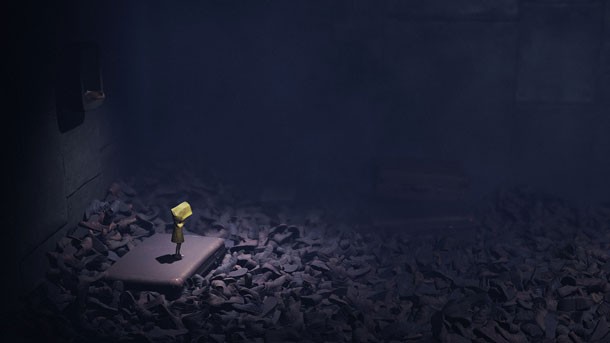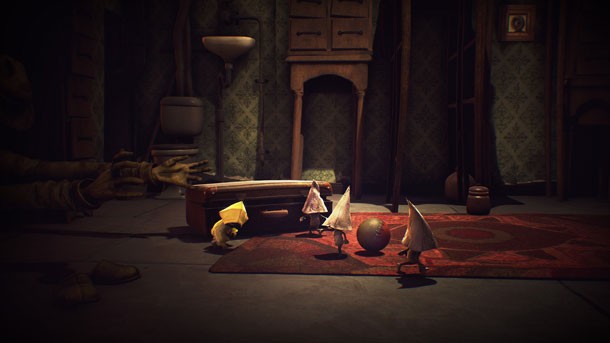Our extra-large special edition is here. Subscribe today and receive the 25% longer issue at no extra cost!
Little Nightmares Afterwords – On Making A Game That Puts Quality Over Length

Tarsier Studios’ atmospheric puzzle-platformer Little Nightmares has captivated – and unnerved – players since its release. We spoke with narrative designer Dave Mervik about cultivating mystery, the merits of being succinct, and the terror of side-by-side toilets.
There have been a lot of comparisons between Little Nightmares and Playdead’s games, even though Little Nightmares and Inside were developed around the same time. What do you think of those comparisons? Do you give them much thought?
We can’t help but think about them, because people keep asking us about them. [Laughs] It’s really solid company we’re standing in when people are talking about us alongside those games. I think I’ve said before, Playdead are the best at being Playdead that there is out there, and I think you’re hiding to nothing if you try and just say, “Hey, let’s make Inside or Limbo and make it look like this.” It’s very cynical. Of course, everyone plays so many games here, but everyone listens to music and watches movies – and so much has inspired and influenced people in the way that they think. I hadn’t played Inside until a few months ago, because I didn’t have a PS4, so I’m off the hook with that game, but I’ve played Limbo. I loved it, but there was never a time where I thought, “Hey, let’s do a Limbo.” It’s just another thing that becomes part of your cultural skull, which is a horrible phrase that I’ve just created. I couldn’t count the amount of things that go through my head when I’m thinking of stuff, and I know it’s the same for everyone else. If people see that in it, there’s nothing we can do to change that. But it’s nice to be compared to amazing games.
Was the game’s short length a concern for you as you were releasing it?
We never really wanted to make a long game. The idea always was to make something that got in and got out – which is a horrible way to put it. Something that didn’t hang around and felt like filler. It’s our first original game as well, so we wanted to make sure that the emphasis was on quality rather than length. What’s amazing is that people do want more. If we did get to make another game in that world in the future, perhaps we’d have a bit more time to make something longer, but it would never be just for the sake of it. If the story we wanted to tell next time was only going to be a certain length to be good, then we’d have to go that way.
Did your studio's previous work on games like LittleBigPlanet and Tearaway Unfolded inform the game's design?
It wasn’t anything that we kind of set out to do – make the dark side of LittleBigPlanet. We even had concerns about having the word “little” in the title, because we didn’t want it to seem as though we were just trading off our experience. They’re very different beasts, but there are those connections to be made when you’re working with physics and stuff.
Why did you change the name from Hunger to Little Nightmares?
We loved the title, because it spoke to the themes that we were keen to explore – you know, this idea of food and the whole grotesque aspect of the game, meat was a huge part of that. The whole unspoken truth about things like meat, it’s those whole ideas that you want to bury and pretend they don’t exist. That was something that we feel is really strong within Little Nightmares, those kind of themes that you’re exploring. As the project evolved more, we were thinking more about the different things that we wanted to bring into the game, and these ideas of childhood worked their way in as well, and that felt like a really strong core to the whole game. But it was something that was not part of the Hunger name, which was a hard thing to acknowledge, because we had all gotten so used to it being Hunger.
I think we used every Post-It note in the entire building when we were trying ideas of what it could be. And then we had to collect those Post-It notes and go through them. To cut a long story short, Little Nightmares won because everyone can look at that title and make up their own minds up on what it means and what it signifies. Even though it wasn’t part of the original motivation for calling it Little Nightmares, since then I’ve analyzed it myself and thought, “Ah, it’s because it means.” That’s the English-literature student in me coming out and reinterpreting something. It’s like the death by 1,000 paper cuts kind of thing – it’s not one big scare, but thousands or millions of little nightmares. To me, that’s what we meant the whole time. [Laughs]

The game is ambiguous. Is that something you wanted from the beginning, or did you find that if you told too much it would give too much away?
We knew from the very beginning that we didn’t want to put up big signposts. There are several of us who were involved in this discussion, who had grown a little weary of feeling like a spectator in someone else’s game or movie or whatever. We wanted to get back to where you felt active – and that’s the thing that games do better than anything – that you’re supposed to be active in this world. As well as pressing the buttons and doing all that stuff, I think it has to go to storytelling as well. You have to feel a lot more active in figuring out what’s going on and actually thinking about what you’re seeing. Honest to god, I am stunned by what we’re already seeing, the work that people are going into analyzing this game. We have put a lot of effort into putting those details there and we’re thinking about the layers that people could dig into if they want. It is hard to strike a balance though, because you don’t want to be willfully vague or not give people anything to hang their hat on. But you don’t want to not trust the player at the same time. You don’t want to assume, “Well, they won’t get that. They’re not as clever as we are.”
Take the origin of Six’s name – is that something that you and your team have thought about and have an explanation for, even if you don’t feel as though it’s necessarily a rewarding one?
That’s it. The name Six is probably as old as the game. It was very early on I came up with that one, because I liked the questions it asks. It’s not just giving someone your standard name, like my name, Dave, it doesn’t mean anything, so there aren’t any questions about that. With this, it can mean so many things. I think “Why?” is a really fun question. What I also like about it is that there’s no importance about gender, and while it’s not something I think I want to start advertising, “Hey, check us out, how cool are we?” there’s something I like that marries really well with the idea of this child protagonist. Kids don’t care about that stuff; adults do. Kids only care about it when adults teach them that they should. So it feels really nice to capture any of that spirit in the character’s name; the most important thing about Six is that she’s a kid. It’s not about whether she’s a girl or a boy, it’s about a kid trying to survive in this world of monstrous grownups.
The chefs in particular are amazing. The idle animation they have where they scratch underneath what I didn’t realize at first was a skin mask…
It’s disgusting, isn’t it? It’s always the thing I mention in any interview – “What’s the scariest thing in the whole game?” It’s the chef. Putting your fingers under your face is not right in any world. I think again it’s something that’s really thematically brilliant – and this is part of everyone being on board with the ambitions you have in the beginning. Showing the underside of things, showing the hidden stuff. It’s themes we’re trying to explore in as many different ways as possible, and that is just the most disgusting interpretation of what’s going on under the surface I’ve ever seen.
For me, the most unnerving detail is when you go to their living areas, and their bathroom has side-by-side toilets. That little detail says a lot.
It’s always in the details. That’s such a perfect example of not saying too much. You don’t need any more than side-by-side toilets – and I think that’s just a general rule for life. [Laughs]

Get the Game Informer Print Edition!
Explore your favorite games in premium print format, delivered to your door.
- 10 issues per year
- Only $4.80 per issue
- Full digital magazine archive access
- Since 1991








